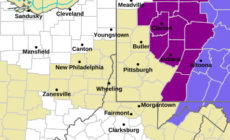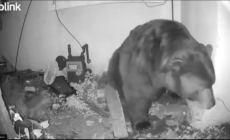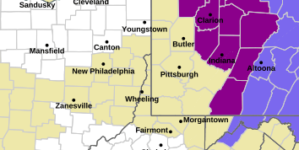-
Thailand and Cambodia Reach Cease-Fire in Brutal Border War - 21 mins ago
-
Why Sears’s Last Great Hope Was a Promise That Never Materialized - about 1 hour ago
-
Pennsylvania ice storm warning map shows where hazards possible - about 1 hour ago
-
What Went Wrong Before Hong Kong’s Inferno - 2 hours ago
-
Jury Declines Murder Charge Against Parent in Kentucky State Shooting - 3 hours ago
-
Top Michigan Recruit Demands Release Immediately After Kyle Whittingham News - 3 hours ago
-
Annette Dionne, Last of the Celebrated Quintuplets, Dies at 91 - 3 hours ago
-
The Race to Save the Sacramento Mountains Checkerspot Butterfly - 4 hours ago
-
A bear has been under an Altadena home for a month. A trap caught the wrong one. - 4 hours ago
-
How to Watch Czech Republic vs Canada: Live Stream 2026 IIHF World Junior Hockey Championship, TV Channel - 4 hours ago
New York Snow Map Shows Areas Getting Heaviest Snow
Northern New York is set to get up to an additional 7 inches of snow from Wednesday through Thursday, according to forecasters at the National Weather Service (NWS).
Why It Matters
The heavy snowfall will impact travel for New Yorkers in the affected counties. Roads will be slippery and there is a possibility of fallen tree branches.
What To Know
The map below shows the following counties affected by the storm:
Oneida County
The NWS issued a winter storm warning for Northern and Southern Oneida County at 4 a.m. ET Wednesday. The warning will last until 1 a.m. ET Thursday and will affect cities including Boonville, Rome and Utica.
Forecasters predict between 3 and 6 inches of additional snow accumulations with the heaviest snowfall to occur across the southern Tug Hill. There will also be wind gusts up to 50 mph, mainly in southern Oneida County.
Oswego, Jefferson and Lewis Counties
In a winter storm warning issued shortly before 10 a.m. ET Wednesday, the NWS said Oswego, Jefferson and Lewis Counties will also get between 3 and 6 inches of additional snow accumulations with wind gusts up to 45 mph. Affected cities include Oswego, Watertown and Lowville.
The warning is in effect until 1 a.m. ET Thursday.
Herkimer, Hamilton and Fulton Counties
The NWS said in a winter storm warning issued shortly after 3:20 a.m. ET Wednesday that Northern and Southern Herkimer, Northern and Southern Fulton and Hamilton Counties will get between 3 and 6 inches of additional snow accumulations and wind gusts up to 50 mph.
The warning is in effect until 1 a.m. ET Thursday and includes the cities of Eagle Bay, Nobleboro, Hoffmeister, McKeever, Big Moose, Little Falls, Northwood, Gloversville, Herkimer, Sabattis, Old Forge, Johnstown, Mohawk, Frankfort, Wells, Long Lake, Atwell, Caroga Lake, Ilion and Dolgeville.
Franklin County
In a winter storm warning issued at 2:20 a.m. ET Wednesday, the NWS said Southern Franklin County was to be hit with an additional 3 to 5 inches of snow. The warning is in effect until 10 p.m. ET Wednesday and will impact cities including Saranac Lake and Tupper Lake.
St. Lawrence
The NWS issued a winter storm warning for Southeastern St. Lawrence County at 2:20 a.m. ET Wednesday. The warning will end at 10 p.m. ET Wednesday.
Forecasters predict between 5 and 7 inches of additional snow accumulations in affected cities including South Colton and Star Lake.

John Normile/Getty Images
What People Are Saying
The National Weather Service (NWS) said in one of its Wednesday warnings: “If you must travel, keep an extra flashlight, food, and water in your vehicle in case of an emergency.
“Be prepared for slippery roads. Slow down and use caution while driving. If you are going outside, watch your first few steps taken on stairs, sidewalks, and driveways. These surfaces could be icy and slippery, increasing your risk of a fall and injury,” the weather service added.
What Happens Next
New Yorkers can check local weather forecasts for the latest information on their areas. The NWS issues regular updates on its website.
To prepare for a winter storm, consider weatherproofing your home. Make sure you have a smoke detector and a battery-operated carbon monoxide detector near heat sources.
For your car, get the radiator system serviced or check the antifreeze level yourself with an antifreeze tester. You should also replace your windshield wiper fluid with a wintertime mix and check that your car tires have enough tread and air pressure.
Also, make sure you have an emergency kit in your car with a portable charger, a flashlight with extra batteries, a first-aid kit, a pocketknife, a shovel, a windshield scraper, and extra clothing to keep warm and water and snack food.
A full list of emergency items can be found on the U.S. Centers for Disease Control and Prevention’s website.
Source link













